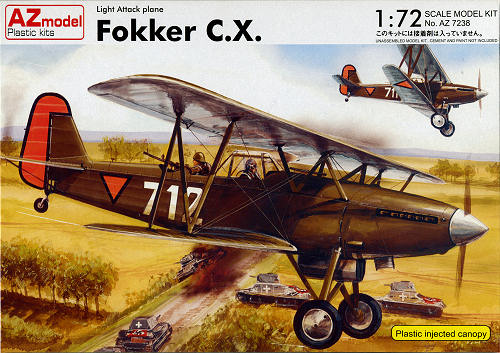
AZ Model 1/72 Fokker C.X
| KIT #: | AZ 7238 |
| PRICE: | $14.30 on sale at GreatModels ($32.15 SRP) |
| DECALS: | Three options |
| REVIEWER: | Scott Van Aken |
| NOTES: | Short run kit with resin and photo etch parts |

| HISTORY |
The Fokker C.X was a biplane scout and light bomber designed in 1933. It had a crew of two (a pilot and an observer).
It was originally designed for the Royal Dutch East Indies Army, in order to replace the Fokker C.V. Like all Fokker aircraft in that period, it was of mixed construction, with wooden wings and a welded frame covered with aluminium plates at the front of the aircraft and with linen at the back. The prototype was built in 1934 with a Rolls-Royce Kestrel V engine.
The East Indies Army ordered 13 C.Xs, but they were soon replaced in the scout/light bomber role by the American Martin B-10s. Until the Japanese attack on the Dutch East Indies in 1941, the C.X remained in use as a trainer and target tug.
The Dutch Air Force ordered 16 C.Xs, and four more C.Xs with Kestrel IIS engines. These four were later re-equipped with Kestrel V engines, because the Kestrel IIS was not very reliable.
Two C.Xs were delivered to the Spanish Republic, and four more to Finland. The Finnish also license-produced 35 C.Xs until 1942. These C.Xs were equipped with Bristol Pegasus XII engines.
Airspeed Ltd. in Great Britain arranged a license to build C.Xs for the British market as the Airspeed AS.22, but no orders were received.
| THE KIT |
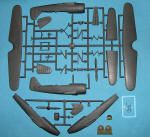 Typical
of many short run kits, this one is a main sprue plus an additional sprue to
take care of the differences between variants. It is obvious from the main sprue
that this kit was originally designed for the radial engine version used by the
Finns as you get the fuselage halves for that kit. This, however, is the inline
type that
Typical
of many short run kits, this one is a main sprue plus an additional sprue to
take care of the differences between variants. It is obvious from the main sprue
that this kit was originally designed for the radial engine version used by the
Finns as you get the fuselage halves for that kit. This, however, is the inline
type that 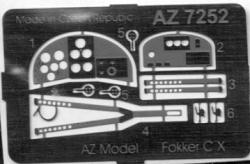 was
used by the Dutch, so the additional sprue includes different fuselage halves, a
new fin a new prop and a new radiator bath for under the fuselage.
was
used by the Dutch, so the additional sprue includes different fuselage halves, a
new fin a new prop and a new radiator bath for under the fuselage.
There is frame and equipment detailing on the inside of the fuselage halves and on the cockpit floor. A resin seat is provided for the pilot and one of those canvas slings for the rear gunner. Photo etch takes care of the pilot's harness (guess the guy in back does not get one) and the instrument panels as well as some bits and pieces for the rear gun.
The builder will have to construct a gun sight tube
and mount, but that looks like the extent of buyer supplied bits. A once piece
canopy is also provided. I have found that on AZ Model kits, often times the
placement holes for struts and gear are too shallow so be advised that you may n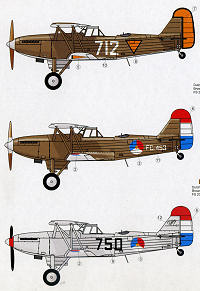 eed
to deepen those. I would also get a metal oil cooler from Aeroclub as the kit
provided one is lacking in detail.
eed
to deepen those. I would also get a metal oil cooler from Aeroclub as the kit
provided one is lacking in detail.
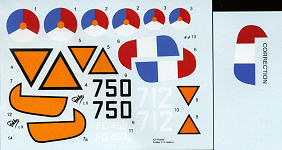 Kit
instructions provide well done diagrams and generic painting information. There
is no rigging diagram so the box art will be your best guide. The back of the
box is where you will find camo and markings information for your decals. These
planes were all originally painted with aluminum dope inside and out so one of
the markings options is so done. This plane has the older insignia and rudder
stripes. There is an interim scheme with the fulselage, upper lower wing
and tailplanes in OD, still with the older insignia, and finally one shown on
the box art with the later orange triangles and all upper surfaces in Dutch
Fokker Brown. The decals are well printed and very thin. My experience with them
is that they tear easily so use caution when applying them.
Kit
instructions provide well done diagrams and generic painting information. There
is no rigging diagram so the box art will be your best guide. The back of the
box is where you will find camo and markings information for your decals. These
planes were all originally painted with aluminum dope inside and out so one of
the markings options is so done. This plane has the older insignia and rudder
stripes. There is an interim scheme with the fulselage, upper lower wing
and tailplanes in OD, still with the older insignia, and finally one shown on
the box art with the later orange triangles and all upper surfaces in Dutch
Fokker Brown. The decals are well printed and very thin. My experience with them
is that they tear easily so use caution when applying them.
| CONCLUSIONS |
If you want subjects like this, then short run or resin or vacuform are often the only way to go. They do require some additional work and are a great way to improve your modeling skills. What's best is that you will have a great looking model in the end and something different from the norm to put on your display shelves.
| REFERENCES |
http://en.wikipedia.org/wiki/Fokker_C.X
March 2012
I picked this one up on sale at GreatModels. Visit them for great deals all the time.
If you would like your product reviewed fairly and fairly quickly, please contact the editor or see other details in the Note to Contributors.